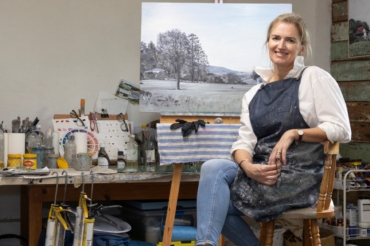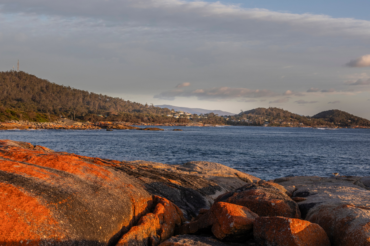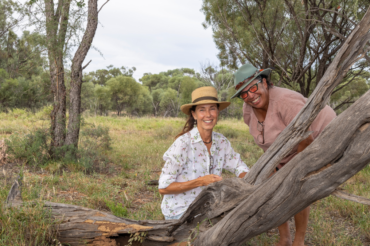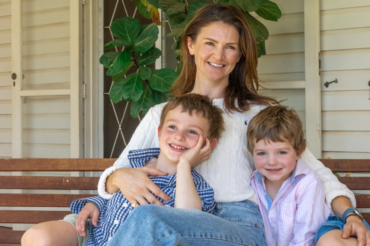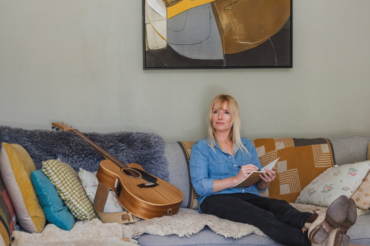
Danelle Bergstrom divides her time between Hill End in NSW and the islands of Åland in the middle of the Baltic Sea.
As artist Danelle Bergstrom surveys her home and studio in the historic village of Hill End near Bathurst in the former NSW goldfields, she describes buying the property as the most outrageous, but the best thing she’d ever done for herself and her children.
“I’d come to Hill End to get away from Sydney for the weekend with my children, Alexarndra and Shannan,” she recalls. “They were 11 and 14 at the time and needed the space to roam free and enjoy some country peace. They actually spotted the house and, when we found it was for sale, begged me to buy it. The ad for it was a bit of foolscap paper attached to the cafe noticeboard with photo corners. I rang the number, talked to the owner and bought it over the phone. I hadn’t even seen inside, but it felt like the right thing to do.”
That was in 1997 and, as Danelle quickly discovered, she was just the most recent in a long line of creatives to respond to the call of the historic bush village with its remnants of the 1870s goldrushes and Victorian buildings lining the streets. Since the 1940s, eminent Australian artists ranging from Russell Drysdale, John Olsen and Donald Friend to Jean Bellette, Margaret Olley, Jeffrey Smart, Brett Whiteley and Ben Quilty have visited the tiny town, population around 80, to focus on their work. Since 1994, the Bathurst Regional Art Gallery (BRAG) has supported this trend through one of Australia’s most celebrated artists in residency programs and more than 350 artists have drawn inspiration from time spent in the village.
Danelle has lived and worked there on and off ever since, and the inspiration she has taken from the bucolic setting was evident in a recent retrospective of her work held at BRAG. Called Afterglow, the exhibition chronicled her work across the past 25 years, ranging from major landscapes and portraits to intimate sketches and drawings. It included works from Hill End, as well as seascapes inspired by her “other home”, the autonomous archipelago of Åland located in the middle of the ocean between Finland and Sweden. The Swedish-speaking region of Finland is made up of 6700 islands, and the majority of its 30,000 inhabitants live on the main islands.

Danelle says she was born with a pencil in her hand, and with her younger sister Dana (who won the Eureka Science Award in 2021) grew up in a creative environment encouraged by her mother, who worked as a commercial artist, hand painting slides for cinema advertising. “Our time together was one of exploration, invention and imaginative play. Painting and sculpture were part of that,” she says. “It wasn’t a pristine house, there were always books on the floor and ongoing work on the table. Mum routinely brought work home on the weekend and the three of us would continue our creative pursuits. I just thought everyone lived like we did.”
At 15, she began studying at the Julian Ashton Art School and, after receiving a degree from Alexander Mackie College, she became a high school art teacher. She then went on to teach at a tertiary design school in North Sydney, the KvB Institute, before giving it all up to paint fulltime in 1991. She’d sold her first painting in 1973 and her creative instincts were never far from the surface. During the 1980s, she started painting seriously. Throughout the ’90s, she completed both public and private commissions for a host of Australian luminaries ranging from artists Margaret Olley, playwright David Williamson and actor Jack Thompson to six chief justices of the NT Supreme Court and Sydney Dance Company principals Graeme Murphy and Janet Vernon. Between 1995 and 2016, she was a finalist in the Art Gallery of NSW Archibald Prize nine times and she’s been a finalist in the SH Ervin Gallery Portia Geach Memorial Prize
15 times.
Danelle admits she falls “in love” with her sitters as she spends intensive time with them before they even enter the studio. “I meet them in their own space as that speaks volumes about the person,” she says. “We spend time gettting to know each other, because we both have to feel comfortable in each other’s company. I’ll come away with hundreds of ideas, but I need to narrow it down to a few. Once we’re in the studio, I work as rapidly as I can so I don’t waste time.”
She confesses she’s not much interested in politicians, but made an exception, however, when she painted former Finnish president Tarja Halonen, who is an inspirational figure as the first female president of Finland. “It’s always rewarding to meet interesting and thought-provoking people, whether they are well-known or not,” she says.
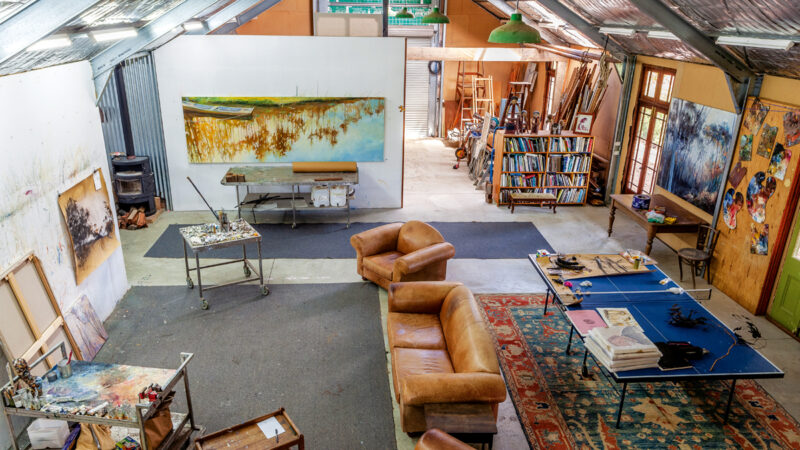
The death of her beloved mother in 1997 was a pivotal event, as it opened the door for her to discover more about her Swedish father. “I’d always been curious about my heritage, but I didn’t dwell on it because I didn’t want to upset Mum,” Danelle says. “I first enquired about my father when she was dying, because I thought perhaps he should know, only to discover that he had died in the 1980s. I discovered I had an uncle and two half sisters and we began corresponding.”
Tragedy intervened in 2000, when her son Shannan died suddenly and in the midst of impenetrable grief, Danelle made her first trip to Sweden with her daughter. This was the beginning of a life that’s been divided between the two hemispheres ever since. This led to a year-long trip to Sweden, an artist’s residency and a solo exhibtion in 2011–12.
“During this time I was encouraged to apply for a residency on the uninhabited island of Kallskar,” Danelle says. “I was accepted but had to postpone until 2016 because of exhibition commitments in Australia. That was the easy part. Getting there was another story as no travel agent in Australia knew how to get me there. It takes hours of ferry hopping from island to island before you finally charter a small boat to take you to the tiny island.”
Given the complexity of the journey, Danelle packed all her materials — paper, inks, pencils and sketchbooks — clothes and enough dehydrated food for the fortnight in a single bag and took a leap of faith that all would be well when she got there. “My home for the next fortnight was a little studio with a sauna out the back,” she says. “There was no phone, no internet, no electricity and the only fresh food available was when I climbed the cliffs to pick blueberries. I wouldn’t walk on my own in a city street at night, but I felt remarkably safe there.”
She also experienced a complete lightening of her emotional load and, given there was not another soul on the island, responded in what felt the most natural way possible, by shedding her clothes, not because it was hot, but more as an expression of freedom. Liberating though it may have been, she was caught unawares by a boatload of visitors. “I was down at the beach rinsing off my lunch plate when I heard voices,” she recalls. “With the plate insufficient to cover any part of me, I collected what dignity I had left and returned calmly to my studio.”
In a stroke of serendipity, her next boatload of visitors turned out to be a group of four Australian women who live in Mariehamn on the main island. They have become firm friends and even introduced her to Kenneth Holstrom, who last year became her husband.
“Romance was the last thing on my mind,” Danelle says. “I was too busy with an exhibition to be distracted by anything but we enjoyed each other’s company and became great friends. That grew into a deep and caring love and it seemed natural to marry. Bergstrom means ‘mountain stream’ and Holstrom means ‘island stream’ so we’re nature buddies as well as soul mates.”
The artistic outcome of the residency was a body of seascapes called Våga, which, appropriately enough, means “to dare” in Swedish. Her recent retrospective, Afterglow, included some of these works along with a series of animated ocean montages from the sojourn. Her studies of the land as a vessel for emotion ranged from paintings from Sweden and Finland to Australia. Her work from Hill End included a couple of poignant depictions of one of her son’s favourite bushland spots called Shannan’s Gully, a poetic image of the bush called Alexarndra’s Lullaby and studies of the bushfires of the summer of 2019/20. These were interspersed with significant portraits and interpretations of the pounding waters of the Baltic Sea .
“I’ve always liked the idea of living close to nature and Hill End is surrounded by bush and wildlife,” Danelle says. “I have good friends here, so I never feel isolated. I’m lucky that I have a trusted friend to look after the place when I’m away. He’s been working with me since he was 14 and has helped with lots of projects. He now has a thriving landscape business.”

When Australian Country visited, completing a loft bedroom above the studio was on the to-do list. “The thing is when I’m in the frenzy of working, I stay in the studio and don’t even go back to the house to sleep,” she explains. “For the 12 or 18 months leading up to an exhibition, I work day and night. I eat when I’m hungry and sleep when I’m tired … I lose all concept of time.”
Even with the retrospective done and dusted, Danelle has a full schedule in front of her. She’s headed back to Åland to be reunited with Kenneth and continue work inspired by a community project. Her largest undertaking so far, the multi-sensory project will include painting, video, sound, and a book to document a village effort to build a 25-metre two-masted schooner called Emelia using traditional Scandinavian ship-building techniques.
“I became aware of the project when I was there in 2018,” she explains. “Kenneth is the master ship builder and explained that traditionally it was the community that built ships. The exhibition will be in 2025 shortly after Emelia’s launch in the summer.”
Given her perpetual motion, a string of commissions and trips between Australia and Åland, there are never enough hours in the day. “As I child, I can remember being resentful of having to stop to eat because I couldn’t get everything I wanted done,” Danelle says. “I am, however, now aware that there’s merit in boredom or standing still; it’s really important to stop and take stock of what’s going on around you. I’m trying to make a conscious effort to take time in every day to walk, take a breath, meditate or at least practice yoga or Pilates. You must feed the soul so you can continue to create.”
Photography Ken Brass

